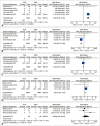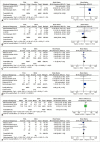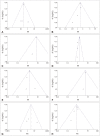Surgical Outcomes of Endoscopic Endonasal Versus Transcranial Resections of Adult Craniopharyngioma: A Meta-Analysis
- PMID: 36347637
- PMCID: PMC9650119
- DOI: 10.14791/btrt.2022.0014
Surgical Outcomes of Endoscopic Endonasal Versus Transcranial Resections of Adult Craniopharyngioma: A Meta-Analysis
Abstract
Background: The endoscopic endonasal approach (EEA) has been gaining popularity for resection of adult craniopharyngiomas. However, the safety and effectiveness of the procedure in comparison to the traditional transcranial approach (TCA) remains unestablished as previous reviews are outdated.
Methods: A literature search without language restriction was conducted in PubMed, Cochrane database, and Web of Science from conception to July 9, 2021. Cohort studies and case series that compared EEA with TCA and assessed postoperative complications, recurrence, and 30-day mortality were included. Articles, where data for adult populations could not be extracted or calculated, were excluded. Article selection and data extraction in a predesigned data extraction form were conducted in duplicate. Pooled participant data were included in a random-effects model.
Results: The search yielded 227 articles, from which eight cohort studies containing 11,395 patients were included (EEA: 6,614 patients, TCA: 4,781 patients). Six studies were good quality and two were fair quality according to the Newcastle Ottawa Scale. There were significantly higher rates of cerebrospinal fluid leak (risk ratio [RR]=0.23, 95% confidence interval [CI] 0.17-0.32, p<0.00001, I²=0%) and lower rates of postoperative hypopituitarism (RR=1.40, 95% CI 1.30-1.51, p<0.00001, I²=0%), hydrocephalus (RR=6.95, 95% CI 5.78-8.36, p<0.00001, I²=0%), visual impairment (RR=1.52, 95% CI 1.34-1.73, p<0.00001, I²=0%), and 30-day mortality (RR=5.63, 95% CI 3.87-8.19, p<0.00001, I²=0%) after EEA. Non-significant lower rates of postoperative diabetes insipidus (RR=1.12, 95% CI 0.78-1.61, p=0.53, I²=85%) and recurrence of tumor (RR=2.69, 95% CI 0.35-20.81, p=0.34, I²=47%) were seen after EEA.
Conclusion: EEA may be associated with reduced postoperative hypopituitarism, hydrocephalus, visual impairment, and 30-day mortality and higher rates of cerebrospinal fluid leak. These findings do not account for differences in tumor size and extension between the EEA and TCA cohorts. Further research on patients with comparable tumor characteristics is required to fully assess outcomes.
Keywords: Craniopharyngioma; Craniotomy; Minimally invasive surgery; Neuroendoscopy.
Copyright © 2022 The Korean Brain Tumor Society, The Korean Society for Neuro-Oncology, and The Korean Society for Pediatric Neuro-Oncology.
Conflict of interest statement
The authors have no potential conflicts of interest to disclose.
Figures




Similar articles
-
Endoscopic Endonasal Approach for Craniopharyngiomas with Intraventricular Extension: Case Series, Long-Term Outcomes, and Review.World Neurosurg. 2020 Dec;144:e447-e459. doi: 10.1016/j.wneu.2020.08.184. Epub 2020 Sep 2. World Neurosurg. 2020. PMID: 32890848 Review.
-
Craniopharyngioma resection by endoscopic endonasal approach versus transcranial approach: A systematic review and meta-analysis of comparative studies.Front Oncol. 2022 Nov 30;12:1058329. doi: 10.3389/fonc.2022.1058329. eCollection 2022. Front Oncol. 2022. PMID: 36530998 Free PMC article.
-
Endoscopic endonasal versus transcranial surgery for primary resection of craniopharyngiomas based on a new QST classification system: a comparative series of 315 patients.J Neurosurg. 2021 Mar 5;135(5):1298-1309. doi: 10.3171/2020.7.JNS20257. Print 2021 Nov 1. J Neurosurg. 2021. PMID: 33668037
-
Endoscopic endonasal versus open transcranial resection of craniopharyngiomas: a case-matched single-institution analysis.Neurosurg Focus. 2016 Dec;41(6):E7. doi: 10.3171/2016.9.FOCUS16299. Neurosurg Focus. 2016. PMID: 27903116
-
Endocrine and Metabolic Outcomes After Transcranial and Endoscopic Endonasal Approaches for Primary Resection of Craniopharyngiomas.World Neurosurg. 2019 Jan;121:e8-e14. doi: 10.1016/j.wneu.2018.08.092. Epub 2018 Sep 26. World Neurosurg. 2019. PMID: 30266691
References
-
- Karavitaki N, Cudlip S, Adams CB, Wass JA. Craniopharyngiomas. Endocr Rev. 2006;27:371–397. - PubMed
-
- Li X, Wu W, Miao Q, He M, Zhang S, Zhang Z, et al. Endocrine and metabolic outcomes after transcranial and endoscopic endonasal approaches for primary resection of craniopharyngiomas. World Neurosurg. 2019;121:e8–e14. - PubMed
-
- Fernandez-Miranda JC, Gardner PA, Snyderman CH, Devaney KO, Strojan P, Suárez C, et al. Craniopharyngioma: a pathologic, clinical, and surgical review. Head Neck. 2012;34:1036–1044. - PubMed
-
- Kassam AB, Gardner PA, Snyderman CH, Carrau RL, Mintz AH, Prevedello DM. Expanded endonasal approach, a fully endoscopic transnasal approach for the resection of midline suprasellar craniopharyngiomas: a new classification based on the infundibulum. J Neurosurg. 2008;108:715–728. - PubMed
-
- Campbell PG, McGettigan B, Luginbuhl A, Yadla S, Rosen M, Evans JJ. Endocrinological and ophthalmological consequences of an initial endonasal endoscopic approach for resection of craniopharyngiomas. Neurosurg Focus. 2010;28:E8 - PubMed

